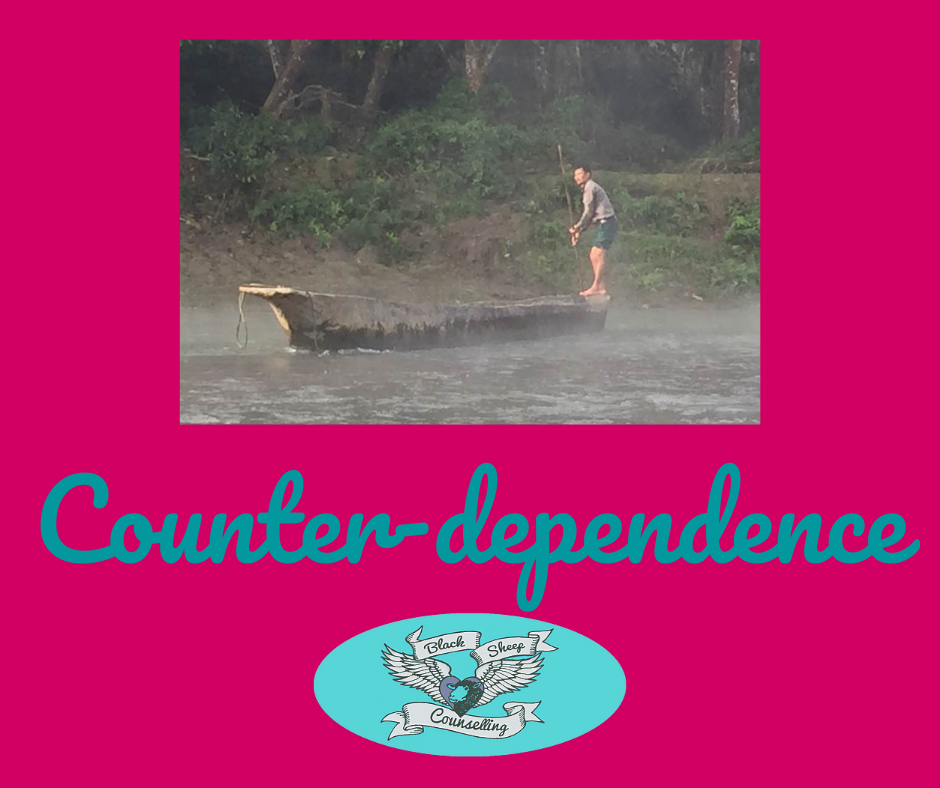Counter-Dependence

Most people are familiar with the term “co-dependency”. Co-dependency often presents as a caring individual supporting another individual to a detriment to both themselves and the person that they are trying to “help”. The co-dependent person loses connection with Self (putting their overall wellbeing at risk) and the person they are trying to “help” also suffers (the excessive support can take away agency and inhibit personal growth).
On the other end of the spectrum is counter-dependence which presents as extreme independence. Counter-dependence develops in early life as one of the insecure attachment patterns known as an “avoidant attachment” character style (for more on attachment theory see here: https://blacksheepcounselling.com/2019/03/adult-attachment/ and here: https://blacksheepcounselling.com/2017/12/attachment/).
Insecure forms of attachment result as a misattunement between infants and primary caregivers (in addition to avoidant, there is also anxious and disorganized insecure attachment styles). An avoidant attachment style is characterized in the young child as a lack of willingness to accept help and a suppressed emotional reliance on caregivers. It is important to recognize that this self-reliance is a needed adaptation in early life: it is a survival mechanism. When caregivers chronically do not optimally show up for a child, they learn to become self-sufficient in order to survive. This once needed self-sufficiency becomes problematic as a default switch as it can create a life-long pattern of impeding deepened connection with others.
Counter-dependence can look like stubborn pride, and what developmental psychologists Janae and Barry Weinhold (2008) describe as “a flight from intimacy”. The Weinholds have identified the following seven markers of counter-dependence:
- Difficulty being close to others
- A strong need to be right—all the time
- Self-centered and egotistical
- A resistance or refusal to ask for help
- Expects perfection in self and others
- Extreme discomfort appearing weak or vulnerable
- Has difficulty relaxing and is addicted to activities like work or exercise
Counter dependence (AKA: hyper independence or extreme self-resiliency) can be a reaction to trauma (this holds particularly true for traumas rooted in childhood). However, counter dependence can also be a result of chronic illness that can create a strong aversion to being reliant on others. Individuals desire to feel both a sense of mastery and a need to contribute. For people with hyper independence, their sense of worth is often achieved through the accomplishment of tasks (for more on this, see here: https://blacksheepcounselling.com/2018/05/measuring-up/). People who are counter dependent are usually extremely uncomfortable with ever being a receiver and are resistant to even healthy symbiotic (give-and-take) forms of giving.
If you are a hyper independent person, you are probably aware that trusting others comes particularly hard for you. An important commencement to your own journey of exploring trust can begin by watching this video called the Anatomy of Trust (Brene Brown): https://brenebrown.com/videos/anatomy-trust-video/.
For how to move away from only being a giver in relational transactions, see here: https://blacksheepcounselling.com/2019/04/receiving-as-an-act-of-love/).
Being counter dependent is self-sabotaging behaviour that creates chronic feelings of exclusion and loneliness. We humans thrive in connection to others. Working with a therapist that specializes in trauma can help foster more relationally-attuned ways of being that enhance desired connection and belonging…..moving away from merely surviving and moving towards a “life worth living” AKA: thriving.

